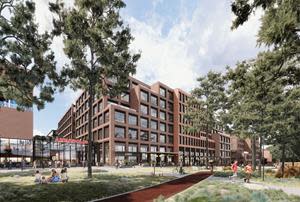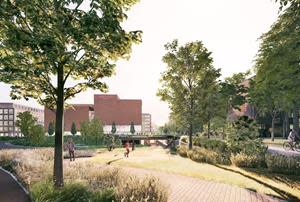Akropolis Vingis: former industrial area in Vilnius's Vilkpėdė district will become a new quarter of the city


AKROPOLIS Vingis 1

AKROPOLIS VINGIS 2

AKROPOLIS VINGIS 3

AKROPOLIS VINGIS 4

Akropolis Group, leader in the Baltic market of shopping and entertainment centres, finished the preparation of the design proposals for Akropolis Vingis, a multifunctional quarter planned in Vilnius district Vilkpėdė. It is planned that the former industrial area will be converted into a new urban quarter with inner streets, concert hall, conference centre, buildings with offices and apartments intended for long-term residential lease, food hall, recreational areas and underground parking lots.
Construction is planned to be started in 2023
According to the plans of the Vilnius City Municipality, former industrial areas in Vilkpėdė located just 5 kilometres away from the Old Town are going to be adapted for the needs of the public. One of the largest conversions of former industrial areas planned in this Vilnius district is a new multifunctional complex Akropolis Vingis, which will emerge in the territory of the Velga factory that was operative until 2000.
“We have designed a new Akropolis Vingis as a multifunctional cultural, entertainment, business and shopping quarter, where buildings of different functions will harmoniously complement each other. In the course of preparation of the design, we had discussions with the Vilnius City Municipality and capital experts of the city architecture and urbanism – we are grateful to them for their valuable comments. We hope that this conversion project will become a significant impulse for both Vilkpėdė and Vilnius as a whole – the former industrial area will turn into a viable urban quarter,” Manfredas Dargužis, the CEO of Akropolis Group, comments.
In the land plot of 14 hectares, the neglected buildings of the former factory have been demolished, the area has been cleaned of debris, contaminated soil has been removed. In the smaller part of the land plot (3.7 ha) by the Neris river, the real estate development company Galio Group is developing a quarter of residential houses reVingis. Meanwhile, in the larger part of the land plot (10.3 ha), the construction of the designed new multifunctional quarter Akropolis Vingis is planned to be started in 2023, after the completion of the preparation of the technical design, obtaining a new document permitting construction and carrying tender procedures for selection of contractors.
Focus on the harmony of different functions
“In designing the new Akropolis Vingis, we studied the latest trends in European architecture and sought that shopping, business, public and residential spaces in the future quarter merge harmoniously. We paid much attention to greenery, community spaces, the integration of the concert hall and the cinema centre. At the same time, we took into account the specifics of the environment, therefore, Akropolis Vingis will become a key impetus for reviving the whole of Vilkpėdė, which is undeservedly forgotten,” comments architect Andrė Baldišiūtė from the architectural firm Do Architects that designs Akropolis Vingis.
The total area of the premises intended for retail trade, services and leisure activities will take up about 100,000 m2. For comparison, such an area in Vilnius Akropolis is 103,000 m2. A universal concert hall designed in the complex will have 2,500 seats or up to 4,000 standing places. The total area of 7 office blocks, to be built above the shopping centre, will reach about 100,000 m2. About 450 apartments for long-term residential lease are planned to be built.
It is planned to create open-air leisure and green spaces – the park, pedestrian and cyclist alleys In the territory of the complex.
Automotive transport to go underground
4,500 parking spaces have been designed in the complex Akropolis Vingis. The parking will be open not only to visitors and employees of the quarter, but also to all Vilnius citizens and city guests. For comparison, there are 3,000 parking spaces by Vilnius Akropolis.
The majority of parking spaces will be in a two-story underground parking lot, which will accommodate about 3,500 cars. One of the largest underground parking lots in the capital city is going to have an underground traffic infrastructure – inner streets, interactive solutions for regulating traffic, wider parking spaces. Cargo ramps for the supply of goods and the removal of waste have also been designed under the building to minimize visual and acoustic pollution.
Two more smaller parking lot storeys, which will accommodate about 900 cars, will be built next to commercial premises, above which apartments intended for long-term residential lease are going to rise. 100 more parking spaces will be situated in the approaches to the complex.
Three separate entrances to the new quarter are planned – from Geležinio Vilko street (for those arriving from the city centre), from Gerosios Vilties street and from Eigulių street. According to the authors of the design, as most of the incoming motor traffic is directed underground, inside the quarter priority will be given to the movement of pedestrians and cyclists. Here, people will be able to enjoy open-air leisure spaces, walk along the over 300 metre long pedestrian alley from Geležinio Vilko street to the Neris river.
The multifunctional cultural, entertainment, business and shopping quarter, which will be located behind the Vingis Park, will be particularly green. A park with pedestrian and cyclist paths is designed between M. K. Čiurlionio street and the future complex of buildings, the roofs of buildings closer to the river will be planted with low-rise plants, inner courtyards of the quarter and roof terraces will be planted with small trees, shrubs and perennial plants.
“The greenery will harmoniously integrate into the general environment of the quarter, which will be dominated by the terracotta colour range, joining spaces of different buildings. The combination of clay red and soil brown has been chosen for the buildings taking into account the colours of the surrounding territories and the nature in the neighbourhood. This structure will be both joined and divided into separate functional areas by shades of grey, black and white,” says A. Baldišiūtė.
The capacity of surrounding streets will increase
In order to improve communication for Vilnius citizens and city guests, at the expense of Akropolis Group, the city transport infrastructure that is next to the quarter will be reconstructed. The current intersection between Geležinio Vilko, Gerosios Vilties and M. K. Čiurlionio streets will be replaced by a roundabout at the start of Gerosios Vilties street, under Geležinio Vilko street there will be the underground pedestrian and bicycle crossing and one of the entrances to the parking lot of the complex. After these infrastructural changes, the intersection of Geležinio Vilko, Gerosios Vilties and M. K. Čiurlionio streets will become unregulated and its capacity will increase. The modern underground passage will become a connection joining Naujamiestis district and the Vingis Park, convenient for pedestrians and cyclists. A part of Eigulių street will also be reconstructed, some approaches to M. K. Čiurlionio street will be taken care of, new cycling and pedestrian paths of 2.5 km will be built.
In accordance with the existing legislation, a permit for the operation of the new complex will be granted only after the developer has completed the implementation of the city transport infrastructure improvement projects. These projects will be implemented at the expense of the developer, under agreements concluded with the municipality, their detailed design solutions will be approved by the municipality before any works are started.
Even distribution of transport flows in the quarter will also be ensured by different intensity of visiting buildings of different functions during the day – office workers will arrive in the morning and leave after working hours. Meanwhile, the flow of visitors to the shopping centre is distributed more or less evenly between 11 and 21, whereas the concert hall visitors will be arriving in the evening, when the flow of shoppers is already falling.
The project will be developed in accordance with the requirements of the international sustainable construction standard BREEAM, tapping green energy. It is expected that after the implementation of the project, approx. 8,000 new jobs will be created in the area of the quarter.
As part of the conversion project, Akropolis Group will use its analogous experience gained in Latvia. The Akropole Riga complex, opened in Riga in 2019, was built in the place of former Kuznetsov's porcelain factory, with the historical heritage of the former factory included in the interior of the shopping centre.
For more information:
Dominykas Mertinas
Head of Marketing and Communication Department
AKROPOLIS GROUP, UAB
+370 64027001
dominykas.mertinas@akropolis.lt
Attachments

